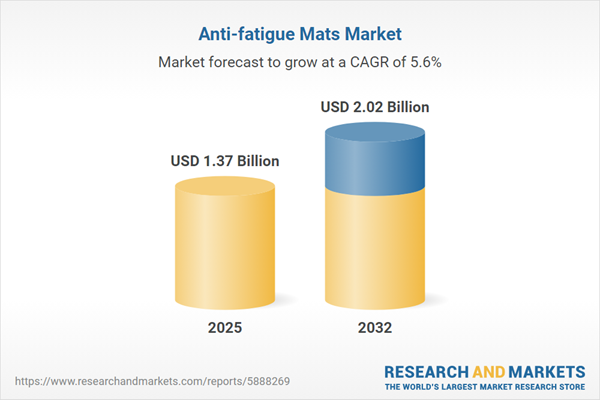Speak directly to the analyst to clarify any post sales queries you may have.
As operational demands evolve, decision-makers in the anti-fatigue mats market are navigating shifting priorities around ergonomic innovation, flexible procurement, and workforce safety. Senior leaders are pursuing solutions that balance compliance, well-being, and supply chain resilience.
Market Snapshot: Anti-fatigue Mats Market
The global anti-fatigue mats market is currently valued at USD 1.30 billion in 2024, with expectations to reach USD 1.37 billion by 2025 and USD 2.02 billion by 2032, underpinned by a 5.64% CAGR. This trajectory is shaped by more stringent regulatory environments, increased investment in ergonomic flooring, and growing interest in material sustainability. Procurement teams are rapidly adopting new digital product configurators and 3D design platforms, speeding up compliance checks and broadening solution identification for diverse operational settings across regions and sectors.
Scope & Segmentation
This report delivers actionable market intelligence for senior procurement and operations leaders seeking to optimize anti-fatigue mat sourcing and implementation strategies. Segmentation reflects current use cases and best practice insights from across the industry:
- Material Types: Composite, foam, gel, rubber, and vinyl materials deliver diverse combinations of sustainability features, ergonomic value, and lifecycle durability across many applications.
- Application Areas: Serving sectors like hospitality, offices, healthcare, manufacturing, food processing, automotive services, kitchens, workshops, and retail, these mats address specific safety and compliance goals unique to each field.
- Thickness Options: Key variants such as 1/2 inch, 1/4 inch, and 3/4 inch enable precise alignment with ergonomic and occupational health standards.
- Distribution Channels: Procurement strategies are supported by specialty retail, supermarkets, hypermarkets, direct supplier platforms, and third-party e-commerce, catering to both centralized and decentralized acquisition models.
- End User Segments: Commercial kitchens, fitness centers, factory floors, retail sites, and residential customers each prioritize wellness and compliance objectives in product choice.
- Regional Focus: Comprehensive regional analysis covers procurement trends and regulations within the Americas, EMEA, and Asia-Pacific, reflecting localized compliance and sourcing behaviors.
Ongoing advancements in mat design and materials are reinforcing industry sustainability initiatives, while also ensuring reliable functional performance over the entire product lifecycle. Organizations are empowered to achieve their safety, operational, and environmental objectives with confidence.
Key Takeaways for Senior Decision-Makers
- Composite and gel-based solutions help organizations advance their sustainability agendas and align with ESG frameworks during procurement cycles.
- Sector-specific adoption is increasing, as organizations in offices, hospitality, healthcare, and manufacturing sharpen their focus on workplace safety and employee wellness programs.
- Digital workspace configurators and interior design tools are enabling greater customization, supporting brand consistency and targeted ergonomic improvements.
- Collaboration between procurement teams and ergonomic specialists accelerates compliant solution adoption and delivers consistency across distributed operational sites.
- Regional market dynamics vary, with North America emphasizing tight regulatory compliance, EMEA prioritizing sustainable procurement, and Asia-Pacific organizations favoring agile, digital sourcing models.
Tariff Impact and Supply Chain Considerations
Recent tariff adjustments affecting key raw materials such as synthetic rubber, foam, and polymers are leading to increased production and logistics costs, particularly within the U.S. market. To counteract these impacts, enterprises are expanding their supplier pools and exploring nearshoring to reinforce supply chain continuity and support reliable inventory flows during market uncertainty.
Methodology & Data Sources
This report synthesizes insights from collaboration with technical and industry experts, referencing regulatory documents, international standards, and patent filings. This robust approach ensures that findings are practical and aligned with current procurement and operational requirements.
Why This Report Matters
- Empowers leadership with current intelligence for effective alignment of procurement, product development, and sustainability initiatives.
- Offers regionally segmented analysis to support cross-border sourcing decisions and adaptation to emerging regulatory and logistical challenges.
- Enhances operational resilience by supporting better resource allocation toward workforce well-being and technology adoption.
Conclusion
Senior leaders can leverage this report to anticipate upcoming industry changes, reduce procurement risk, and strengthen sourcing strategies, supporting sustained organizational effectiveness in the anti-fatigue mats market.
Additional Product Information:
- Purchase of this report includes 1 year online access with quarterly updates.
- This report can be updated on request. Please contact our Customer Experience team using the Ask a Question widget on our website.
Table of Contents
3. Executive Summary
4. Market Overview
7. Cumulative Impact of Artificial Intelligence 2025
Companies Mentioned
The companies profiled in this Anti-fatigue Mats market report include:- New Pig Corporation
- Mapco Rubber Products, Inc.
- Cobalt Enterprises, Inc.
- Floortex Limited
- Ergomat International GmbH
- Rubber-Cal, Inc.
- Dur-A-Flex, Inc.
- Icon Rubber Works, Inc.
- Vestil Manufacturing Company
- Leader Rubber Co., Ltd.
Table Information
| Report Attribute | Details |
|---|---|
| No. of Pages | 196 |
| Published | October 2025 |
| Forecast Period | 2025 - 2032 |
| Estimated Market Value ( USD | $ 1.37 Billion |
| Forecasted Market Value ( USD | $ 2.02 Billion |
| Compound Annual Growth Rate | 5.6% |
| Regions Covered | Global |
| No. of Companies Mentioned | 11 |









